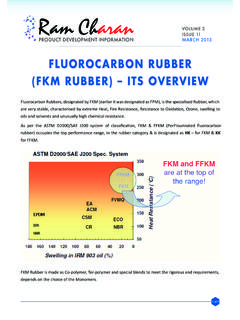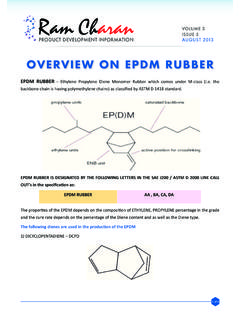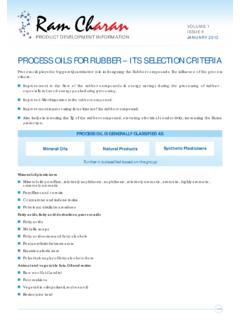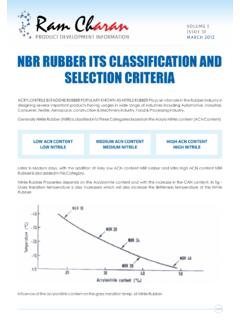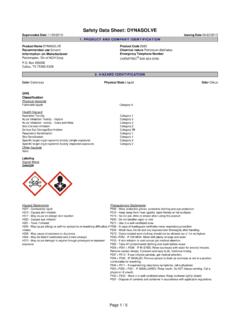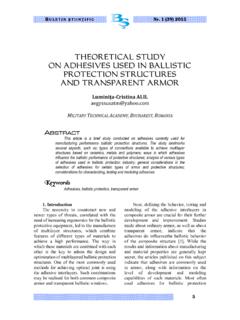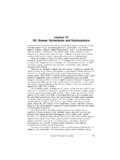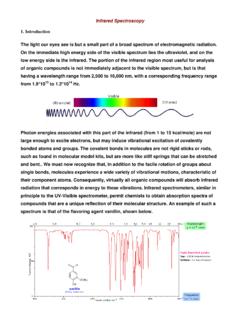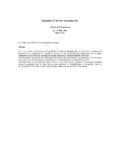Transcription of Role of Polyisocyanate in PU Coatings - Ramcharan
1 PRODUCT DEVELOPMENT INFORMATIONVOLUME 2 ISSUE 2 MAY 20121 of 5 How to make a PU SystemPolyurethanes Coatings are made from macromolecules or polymers formed by the reaction between a Polyisocyanate and another polymer commonly known as a polyol that contains active hydrogens (OH, ).The choice of raw materials, both polyols and polyisocyanates is very large, enabling many combinations with a wide variety of properties. Reaction to form polyurethanePolyurethanes based on aliphatic polyisocyanates are well known for their outstanding properties and especially for their exceptional resistance to weathering and chemical attack. 1K & 2K SystemsPolyurethanes based on aliphatic polyisocyanates are renowned for their outstanding properties and especially for their exceptional resistance to weathering and chemical attack. Two main categories of polyurethane systems can be distinguished: two-component (or 2K) and heat-activated, one-component (or 1K).
2 2K POLYURETHANE Coatings Two-component systems consist of a Polyisocyanate and a polyol that are mixed just prior to application and cure at room temperature. In volume terms, this family accounts for over half of all urethane Coatings sold in the world. Role of Polyisocyanate in PU CoatingsPRODUCT DEVELOPMENT INFORMATIONVOLUME 2 ISSUE 2 MAY 2012 The crosslinking reaction (-NCO + -OH) occurs on the substrate at room temperature, but sometimes, stoving 30 min at 60 C or 80 C is used to speed up drying (for productivity reasons) Therefore, 2K polyurethane Coatings are used : on substrates sensitive to heat (plastics, wood, ), on objects too big to be stoved (trains, airplanes, ). 1K POLYURETHANE Coatings One-component PUs are similar materials to the previous one, except that a blocked isocyanate is used to provide a storage stable one-pack formulations containing the polyol. After application of the coating on the substrate and during stoving at elevated temperature, the isocyanate is de-blocked and then it reacts with the polyol to form the PU network.
3 This includes powder coats, which consume now over 10% of all urethane in paints Why use aliphatic polyisocyanates ?Polyurethane Coatings are highly versatile and have superior properties such as toughness, resistance to abrasion and chemicals while also being flexible and adhering well to all sorts of substrates. aliphatic isocyanates as the curing part for Polyurethanes not only contribute to achieving these benefits but also offer exceptionnal durability, great flexibility and extensive possibilities to formulators. Using aliphatic polyisocyanates providing the following benefits to PU coatingsNo YellowingChemical Resistance ExceptionalGloss Retention2 of 5 PRODUCT DEVELOPMENT INFORMATIONVOLUME 2 ISSUE 2 MAY 2012 Exceptional Gloss RetentionPolyurethane Coatings made from aliphatic polyisocyanates have exceptional gloss retention The lack of phenyl group It makes polyurethane Coatings prepared from aliphatic polyisocyanates less prone to oxidation rather than those prepared with an aromatic hardenersThe resistance of the urethane bond when exposed to UV light aliphatic polyisocyanates provide very good durability to polyurethane Coatings .
4 Their use is recommended for applications where maintaining outstanding aesthetics is required over Yellowing upon AgeingPolyurethane Coatings made from aliphatic polyisocyanates are well known for their non yellowing properties upon ageing. The lack of phenyl group It makes polyurethane Coatings prepared from aliphatic polyisocyanates less prone to oxidation rather than those prepared with an aromatic hardenerThe resistance of the urethane bond when exposed to UV light The use of aliphatic polyisocyanates is particularly suitable when Coatings have to play a durable decorative role. In the automotive market, the topcoat needs to stay as transparent as possible in order to maintain special effects and colors at their best level. In these typical applications, polyurethane Coatings made from aliphatic polyisocyanates are recommended for their no-yellowing property as for their exceptional physical ResistancePolyurethane Coatings based on aliphatic polyisocyanates have a dense chemical network that provides an exceptional chemical resistance.
5 These high performance Coatings are therefore able to withstand acid rain, bird dropping and graffiti removals. A slight excess of aliphatic Polyisocyanate in the coating formulation increases the film resistance to solvent & chemicals attack. In general, the best performance levels are obtained with NCO/OH ratio between and for solvent-based systemsAdhesionThe adhesion property of a paint film is key to ensure good substrate protection or to enable multi-layer coating systems. The challenge is not only to adhere and show a good adhesion property, but to ensure the durability of the adhesion in severe conditions, such as humidity or heat. The urethane bond provides superior adhesion to a wide variety of substrates Adhesion of polyurethane Coatings based on aliphatic polyisocyanates last over time even under harsh of 5 Applications / MarketsThe use of aliphatic polyisocyanates in the following markets NIPPON PU PRODUCT SPECIFICATION CORONATE HR-T ( aliphatic Polyisocyanate ) HardnerApperance Pale Yellow Liquid NCO Content (%) Viscosity at 25 C ( ) 100 Dilute Solvent(weight ratio) Xylene/Butyl acetate=50/50 Solid Content (%) 75 PRODUCT DEVELOPMENT INFORMATIONVOLUME 2 ISSUE 2 MAY 20124 of 5 PRODUCT DEVELOPMENT INFORMATIONVOLUME 2 ISSUE 2 MAY 2012 PHYSICAL PROPERTIES OF FILM Test Item Test Results Test Method Bend test 2 mm (Pass) Cylindrical mandrel (JIS K5600-5-1) Cupping test 10 mm Erichsen Value (JIS K5600-5-2) Falling-weight test 100 cm (Pass) DuPont method inches 500g (JIS K5600-5-3)
6 Scratch hardness Hardness H Pencil method (JIS K5600-5-4) Adhesion test 100/100 Cross-cut test (JIS K5600-5-6) Packing Details Available 18 & 220 litres Barrel. PRODUCT DEVELOPMENT INFORMATIONV O L U M E 1I S S U E 7N O V E M B E R 2 0 114 of 4 Ram ChCompany"Century Towers", 46, Barnaby Road, Kilpauk, Chennai - 600 010 Tel : +44 - 4353 9040 / 41 / 42 Fax : +44 - 4330 7050 Email : | | | | 044 | | | CARBON BLACKT YPICAL SPECIFICATIONTESTPARAMETERSUNITASTMMETHO DN220 MICRONIZEDCARBONBLACKN330 MICRONIZEDCARBONBLACKN326 MICRONIZEDCARBONBLACKA ppearanceBlack FinePowderBlack FinePowderBlack FinePowderIodine Nomg/gD 1510-03121 582 582 5 DBP Absorptioncc/100gD 2414-05114 5102 572 5 Tint Strength% ITRBD 3265116 5104 5111 5 Heating Loss%D 15091 maxAsh Content%D 15061 max1 max1 maxSieve Residue 350 BSS mesh%D in 25 kg bags across all our warehouses. 5 of 5
